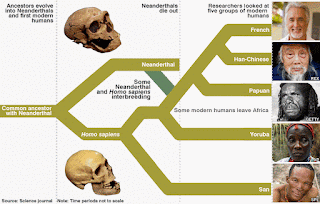 Neanderthal child | In 1997, scientists found the first scrap of Neanderthal DNA in a fossil. Since then, they have recovered genetic material, even entire genomes, from a number of Neanderthal bones. Their investigations have yielded a surprise: Today, 1 to 2 percent of the DNA in non-African people comes from Neanderthals. That genetic legacy is the result of interbreeding roughly 50,000 years ago between Neanderthals and the common ancestors of Europeans and Asians. Recent studies suggest that Neanderthal genes even influence human health today. |  |
 | The DNA extracted in 1997 was from the original specimen of Neanderthals, found in the Neander valley near Dusseldorf, Germany. It suggested that the Neanderthal lineage is four times older than the human lineage, meaning that Neanderthals split off much earlier from the hominid line than did humans. Humans and Neanderthals split from a common ancestor in Africa some 600,000 years ago. At some point afterward, the ancestors of Neanderthals spread to Europe, the Middle East and Central Asia. Along the way, Neanderthals took on a distinctive anatomy — a stocky, powerful build — and became impressive hunters. |  |
 | Now scientists have found that the genes flowed both ways. In a study published in Nature, a team of scientists reported that another instance of interbreeding left Neanderthals in Siberia with chunks of human DNA. In 2010 scientists recovered about 60 percent of a Neanderthal genome from fossils found in a Croatian cave. |  |
 A toe bone from a male Neanderthal dating back at least 50,000 years. | Neanderthals shared certain mutations with living Europeans and Asians, but not with modern Africans. They concluded that humans must have interbred with Neanderthals after leaving Africa. Three years later the complete genome of a male Neanderthal was recovered from a toe bone dating back at least 50,000 years, which had been discovered in the Altai Mountains of Siberia. Comparing the Altai genome to modern human DNA confirmed the interbreeding. |  |

No comments:
Post a Comment